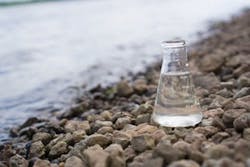Fighting PFOA & PFOS
About the author: Rick Andrew is director of global business development – water systems for NSF Intl. Andrew can be reached at [email protected] or 800.673.6275.
Recent news reports have raised consumer awareness and concern of the presence of perfluorooctanoic acid (PFOA) and perfluorooctane sulfonate (PFOS) in public drinking water supplies. These compounds are not naturally found in the environment and are considered emerging contaminants by the U.S. Environmental Protection Agency (EPA). Part of a group called perfluoroalkyl substances or fluorinated organic chemicals, these manufactured chemicals are used as emulsifiers in the production of fluoropolymers. Their unique ability to withstand water, grease and heat led to their wide use in non-stick cookware, food packaging, insecticides, electronics, stain repellents, paints, plumbing tape and firefighting foam.
Although these chemicals were phased out of production by 2006, large quantities were released into the environment and are still present in water and soil. They have been detected in drinking water supplies in areas near PFOA and PFOS manufacturing facilities like Hoosick Falls, N.Y.; Decatur, Ala.; Oscoda, Mich.; and Little Hocking, Ohio. Data from EPA’s Unregulated Contaminant Monitoring Rule 3 (UCMR3) also revealed detectable levels of PFOA and PFOS in drinking water supplies across the country.
Additionally, PFOA and PFOS have been detected at low levels in blood samples of the U.S. population. Once ingested, these contaminants are absorbed by the body and tend to concentrate primarily in the blood serum, liver and kidneys. Epidemiological studies of workers exposed to high levels of PFOA and PFOS and of residential populations near manufacturing facilities have shown a positive association between serum concentrations and increased cholesterol, decreased bilirubin, low birth weight, immunological effects and cancer.
Animal studies of rats, mice and monkeys exposed to these contaminants have shown increased liver weight, liver hypertrophy, necrosis, developmental and neurodevelopmental delays, decreased spleen weight and delayed puberty. In the body, PFOA and PFOS have a half-life of 2.3 years and 5.8 years, respectively, meaning repeated exposure at low levels can result in adverse health outcomes.
In response to these findings, EPA placed PFOA and PFOS on its Contaminant Candidate List and established health advisory levels for them in drinking water at 70 ppt.
New Product Testing Protocol
After the extent of drinking water contamination became better understood, a need arose for an accepted test protocol to verify the capability of point-of-use (POU) systems to treat drinking water for PFOA and PFOS. NSF Intl. created protocol NSF P473, which established minimum requirements for materials, design, construction and performance of drinking water treatment systems—like POU activated carbon and reverse osmosis (RO) units—to remove PFOA and PFOS. NSF P473 also allows manufacturers to establish confidence for consumers seeking to treat their water for potential contamination.
The protocol was created scientifically by adapting established testing procedures. The basic test protocol methodologies for NSF P473 are based on organic contaminant reduction protocols under NSF/ANSI Standard 53 for activated carbon systems, and on health effects contaminant reduction protocols under NSF/ANSI Standard 58 for RO systems. The extraction testing, contaminant reduction test methodology, structural integrity requirements and product literature requirements are based on NSF/ANSI 53 and 58.
Challenge Water Concentrations
The NSF P473 test protocol uses a mixture of PFOA and PFOS as the contaminant challenge so there is only one test for reduction in which both contaminants are added to the challenge water. The EPA-recommended health advisory level was used as the maximum level allowed in treated water.
The influent challenge levels for PFOS were based on a review of data from EPA’s UCMR3 monitoring samples. Levels were set to the expected value at which 99% of the population will be exposed to waters of lower concentration. This influent challenge level is 1.0 ppb PFOS. Influent challenge levels for PFOA were based on private well and public water supply samples from Hoosick Falls and were set to the expected value at which 90% of the population will be exposed to waters of lower concentration. This approach led to an influent concentration greater than the maximum concentration under EPA’s UCMR3 occurrence data. This influent challenge value is 0.5 ppb PFOA.
To create the challenge water in the laboratory, PFOS and PFOA are added by weight in a ratio of five parts PFOA to 10 parts PFOS to achieve the total influent concentration of 1.5 ppb of PFOS plus PFOA for the test.
Maximum Treated Water Concentrations
NSF P473 establishes a total level of PFOS and PFOA added together of 70 ppt as the maximum allowable treated water concentration, based on the EPA health advisory. EPA considered a variety of toxicological studies and risk assessments when developing this health advisory and incorporated a margin of protection for sensitive populations.
Analysis of PFOA & PFOS
The method of analysis for PFOA and PFOS is specified in Annex E of NSF P473 and involves direct injection of the samples into a liquid chromatography/mass spectrometry system in electrospray negative ionization mode. This sophisticated instrument identifies and quantifies PFOA and PFOS at the low parts-per-trillion concentrations required by NSF P473. NSF’s expert lab validated the analytical methods at the required low concentrations.
Reduction & Product Literature
NSF P473 requires certified systems to include complete, detailed installation, operation and maintenance instructions and to follow requirements for other information included on system data plates, replacement element packaging and performance data sheets. The claim described under NSF P473 is PFOA/PFOS reduction. The protocol requires that the claim be described on the performance data sheet of conforming POU treatment systems.
